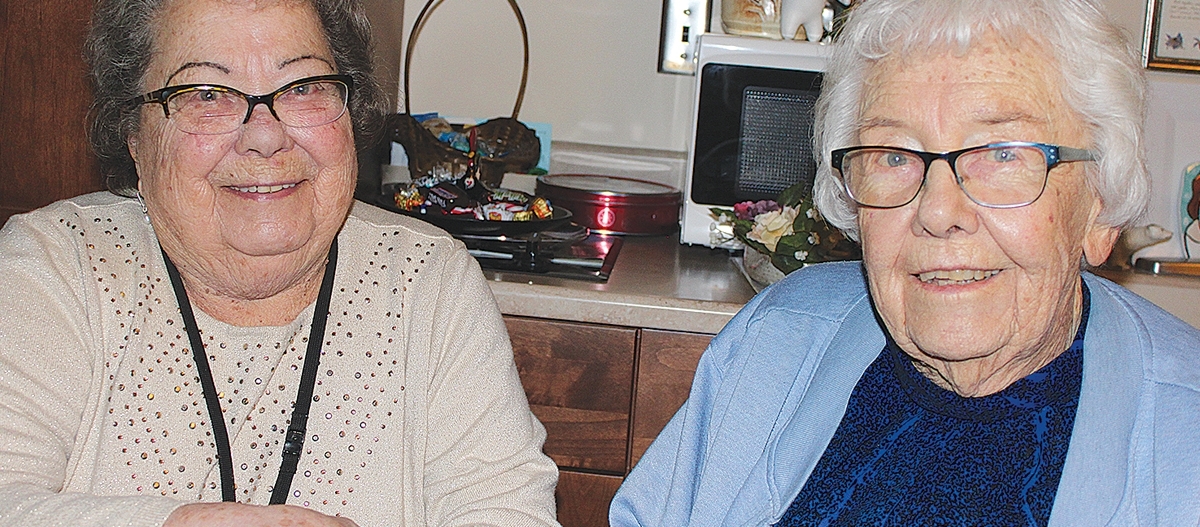Life bends in strange ways, especially for those who live long lives. Marian Jean Setter, 97, and Ruth Katzenberger Lowden, 93, started from different places, were both nurses, and became friends in Great Falls, Mont., after they were 90 years old.
Born in Lewistown in 1922 and always using her middle name, Jean Setter started out on an isolated ranch in the Utica, Mont., area. Her father had worked in the Sapphire Mines and then homesteaded. Over the years the ranch became as large as 1,800 acres and was located a few miles from the Judith Ranger Station, now used as a U.S. Forest Service rental cabin.
Jean’s mother came to the region as a schoolteacher for the Pig Eye Elementary School. Her background in education shaped certain expectations for her daughter.
Jean periodically attended the Pig Eye School, which was named the Sapphire School by the time she became school age. When the weather was severe, her mother taught her at home. Then when Jean was 10, the family purchased a house in Hobson, Mont., where she completed her public school education by graduating in a class of seven. She selected what is now Montana State University to attend college and earned a B.S. in nursing.
Jean was eager to finish college in September 1944, because she had decided to enlist in the U.S. Army.
“I was afraid that the war was going to be over before I had an opportunity to contribute,” she said. She started out working in an Army hospital in California.
At the war’s conclusion, she was assigned to trains conveying soldiers from ships coming into the San Francisco harbor to destinations throughout the United States. Many of the soldiers had been Japanese prisoners of war and were malnourished and often wounded from beatings.
Ruth was three years younger than Jean, but she was drafted into the German army while yet a teenager at a time when she was really unaware of what Nazism was all about. The German war effort needed healthy young boys and girls like her. She was immediately sent to work in the hospitals in Czechoslovakia, where she learned on the job. When the war ended, she and around eight others started out for home.
There were no conveyances; they walked the 500 miles by traveling at night, so Russian soldiers wouldn’t capture them. People along the way gave them food and occasionally shoes to replace those that were worn through.
When she got to Frankfurt, she discovered that her home had escaped bombing, but devastation was everywhere.
“People had been without adequate food for so long that they didn’t realize they were hungry anymore,” she said.
Having taken English in school, Ruth eventually found a job with the Allied Forces during the occupation. She started out as a nanny for an American colonel’s children, but when the colonel heard her speak English, he told his wife, “I need a secretary more than you need a nanny.” Ruth went to work on the Army Post.
One day, some GI’s left a cartoon on her desk and continued to snicker about it. She couldn’t figure out the humor. The cartoon was called “Katzenjammer Kids,” and it depicted children who were always getting into mischief. Apparently, they thought her name Katzenberger sounded like Katzenjammer.
While Ruth was working in a field other than nursing, Jean continued to work as a nurse until she completed her tour of active duty, but she remained in the U. S. Army Reserve. She returned to Great Falls in 1949 and taught at the Deaconess Hospital for Montana State College of Nursing until 1951, when she was called back into the army during the Korean War.
In 1968, she was in Korea and working in the hospital where the abused and tortured USS Pueblo crew that had been captured by the North Koreans came after they were released on Christmas Eve. Every man was processed into the hospital, seen by a doctor and, in some cases, a dentist, and given needed tests before they were sent home.
A later assignment took her to Texas, where she met and shook hands with former President Johnson who occupied the Army hospital’s top floor suite while he was there.
While Jean was taking on assignments across the United States from Boston to Hawaii, and then to Germany, Ruth’s family continued to struggle financially. Ruth’s sister, who had married a GI and moved to Bozeman, Mont., returned to Frankfurt to visit and encouraged Ruth to come to America.
In 1956 Ruth, her husband, and daughter made a life-changing decision. They sailed on a ship to New York City and took a train to Bozeman.
Ruth found a job working in the hospital.
She loved America, and as soon as she could take the courses, she became a citizen. She did nursing both in Bozeman and later in Great Falls. Two years ago, she moved to an Independent living facility and met Jean.
After Jean took the Advanced Army Course at Sam Houston Army Post in San Antonio, Texas, she moved from caring for patients to administrative work. She often worked as chief nurse in huge hospitals.
After 30 years in the Army, serving at 20 different assignment locations, Jean retired in 1976 as a colonel and returned to Montana, where she became active in volunteering.
In reviewing her career, Jean said, “I feel I was fortunate that by practicing my profession, I was able to provide the healing, welfare, and comfort of those who needed those things as well as providing service to my country. I appreciated traveling and learning about other cultures. I met some wonderful people including superior officers and subordinate personnel who became lifelong friends. ”
Jean and Ruth remember their lives during the war, but they don’t dwell on them unless someone asks about those difficult days. They have other interests keeping them busy now. MSN











